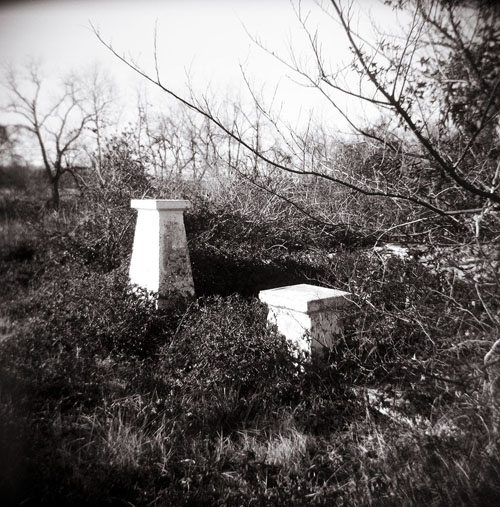By Michelle Parks
A photograph by Phoebe McCormick Lickwar was one of 90 selected from thousands of entries to be included in the Sixth Annual International Juried Plastic Camera Show. The show takes place March 6 through April 22 at Rayko Gallery in San Francisco.
Lickwar is an assistant professor of landscape architecture in the Fay Jones School of Architecture.
Her image, named “Lost Farm, Cave Springs, Arkansas,” shows two pillars from a disappeared farmhouse, possibly from the late 1920s.
Since she arrived in Fayetteville more than a year ago, Lickwar has been researching agricultural sites that are no longer active – farms in various states of decay, with remnants of homes, chicken coops and barns. She’s investigating the transformation of agricultural landscapes over time.
As a landscape architect, photography provides her the chance to connect with the built environment in a “real and physical” way, as opposed to only research that is limited to records and data.
“It’s a way for me to interface with landscape and the built environment one on one,” she said. “I don’t want to lose that connection. I think it’s important to be on the ground and to have an intimate connection with the places I’m studying.”
Lickwar developed an early love of film photography. When she was 13, she built a darkroom in the basement of her parents’ home in Baltimore. Back then, she also roamed the undeveloped land behind her house, spending countless hours exploring the forested terrain. The Arkansas landscape is similar to that from her childhood.
The camera she used to capture the image of the old farmhouse is a black Holga – a model of camera designed by T.M. Lee in 1981 in China. It has a plastic body and plastic lens and uses medium-format film; she typically shoots in black and white.
The camera is about as low-tech as it gets, with no controls for adjusting light exposure or focal length. “You have to know what kind of light you’re shooting in,” she said. “And you have to shoot in the right kind of light so enough will register on the film so you can make a print.”
Lickwar actually relishes the restrictions of this method of photography, which emphasizes the photographer’s experience with the subject.
“You’re not permitted to think about technical aspects of the camera – so you just purely think about the subject matter, what you’re photographing and what you’re seeing,” she said. “It’s a direct tool to get at the heart of what I’m trying to communicate or what I’m trying to discover with the camera.”
She’s been using this camera for 18 years. She orders film through the mail from New York because it isn’t available locally. She gave up developing film in her bathtub after having her two small children. Now, she mails the film to a lab for processing, then scans the negatives for editing and printing.
Lickwar particularly likes the image that results from using this plastic camera. The image obtained through the plastic lens isn’t nearly as sharp as it would be through a glass lens. It also has an area that’s more focused, with the rest fuzzy, lending an almost romantic or antique quality. She prefers to keep the vignette effect that happens on the edges of the frame, rather than crop it.
“I like that unpredictability – because it’s always a surprise,” she said, though she’s gotten better at predicting the results.
In the resulting image, the light becomes sensual, and the image loses many of its details.
“It’s maybe a bolder statement of what you’re trying to say because the image is simplified,” she said.
In many places that are being developed, the sites are built on more quickly, and the old and aging pieces of the landscape are erased and replaced. In those places, observers aren’t given the chance to watch the decay.
Lickwar found the Cave Springs site while driving around the countryside looking for old barns. The landscape had crept in, and all that remained of a former farmhouse were two pillars and a foundation. It’s a relic in a region that’s losing a part of its history, as the ties with subsistence farming fade.
“It’s just amazing to me that those structures are out there, and they’re a visual of the transformation that occurs over time,” she said. “It’s a visible reminder of what’s taking place in our landscape.”
